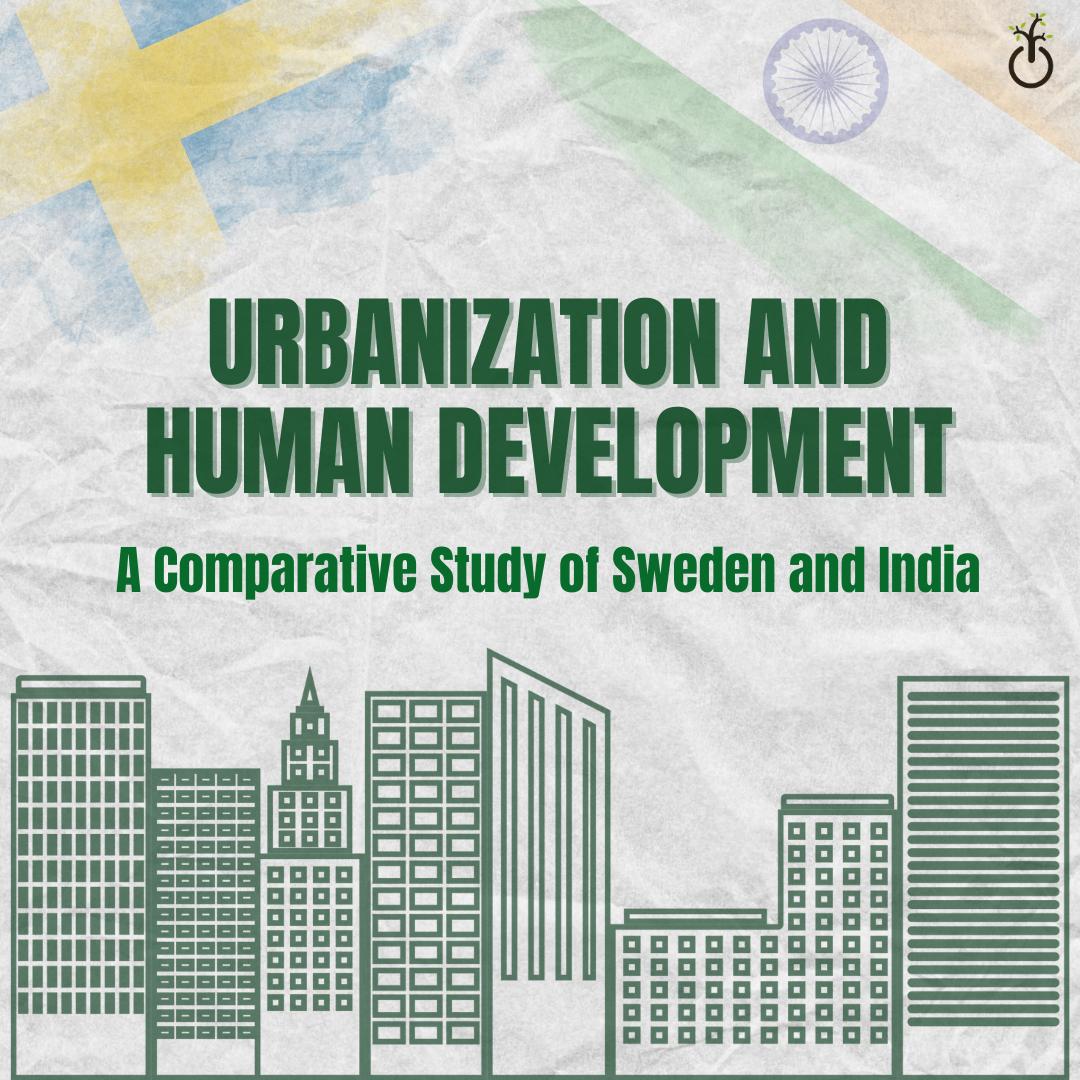The case of Sweden
Sweden is a country with a low level of multidimensional poverty, and even though the UNDP issued a report stating that due to a lack of relevant data, the MPI has not been calculated for the country of Sweden. The report, however, provides many other indexes such as the Gender Inequality Index (GII) where Sweden’s GII value of 0.040, ranks it 2 out of 162 countries on average from the period 2018-2024.
Additionally, the UNDP provided a latest report where it stated that Sweden’s HDI (a summary measure for assessing long-term progress in three basic dimensions of human development: a long and healthy life, access to knowledge and a decent standard of living) was 0.947 points leaving it in 7th place in the table of 191 countries published.
This places the country in the very high human development category—positioning it at 8 out of 189 countries for total development. However, he must consider the control period before the COVID-19 pandemic, as the weights of different sectors significantly changed. It is most notable that between 1990 and 2018, Sweden experienced a significant increase in: HDI value from 0.816 to 0.937, an increase of 14.8 percent; life expectancy at birth raised by 5.0 years, average years of schooling increased by 1.9 years and expected years of schooling increased by 5.9 years. Sweden’s GNI per capita grew by about 58.1 percent. The aforementioned information is documents in the table A:

That being said, this growth of HDI, GNI and etc. is largely due to urbanization dating back to the 1800s which initiated the migration from rural countryside to more urban areas.
As late as 1850, about 10 percent of Swedes lived in towns and cities. In 2015, Sweden was placed in 30th place among countries with the proportionally highest urban populations by having 87 percent of the Swedish population living in urban areas. Sweden’s capital, Stockholm is both the most populous city of Sweden and the most populous city of Scandinavia. Stokclom is experiencing major exponential population growth and it is estimated that Stockholm will hit a population of 3 million by 2045 (largely due to migrants from Afghanistan and Syria). Of course, urbanization poses both advantages and challenges in Sweden.
Positive effects of urbanization:
Urbanization in Sweden today is not happening at the expense of rural areas. Only a fraction of population growth in Sweden’s large cities over the last decades is due to the depopulation of rural areas. High birth surplus, growing life expectancy and immigration from abroad are the real explanations.
While many small localities have disappeared in remote rural areas, hundreds of new small localities have grown up close to the larger urban areas.
Contrary to what one might think, the number of unemployed people is significantly less in Swedish rural areas than in the most populous urban municipalities. Even in percentage terms, the open unemployment rate is on average lower in the country’s densely populated rural municipalities than it is in the most populous urban municipalities.
- More job opportunities and higher employment rates leading to an improved economy that enabled Sweden to expand and flourish into the European metropolis that provides for the inhabitants of Stockholm.
- Less use of automobiles- as more concentrated mass in Stockholm enabled individuals to develop transportation systems like biking-leading to a 5% reduction of carbon dioxide emissions in 10 years. It was also a contributing factor in the city’s winning of the European Green Capital Award, besting 35 other cities in the past.
- Improved economy that enabled Sweden to expand and flourish into the European metropolis that provides for the inhabitants of Stockholm.
- Urban Planning Model City- around 30 major urban development projects are currently underway to make Stokholm a fossil fuel free metropolis by 2040.
- During the period 1996–2001, Stockholm sticks out with 7.0 percent of its neighborhoods experiencing super-gentrification (2.9 percent low-income filtering).
Negative effects of Urbanization:
- Increased energy usage. According to preliminary statistics, Sweden’s greenhouse gas emissions increased by half a million tonnes, putting its total at 63.8 million tonnes of carbon dioxide equivalents.
- Reduce in carbon sinks, thus exacerbating climate change and global warming
- Despite the political ambition to preserve the green structure in the Stockholm region, it is increasingly becoming fragmented by urban expansion; with some 50 % having disappeared from the most centrally located green areas since the mid 1970s. Wetland habitats have greatly declined in the area due to habitat loss and land-use change with loss of biotopes for amphibians, wetland birds, and insects.
Besides the loss of ecosystems mainly due to a decrease in the area of cultivated lands for building and infrastructure development, several environmental effects are associated with population growth in the region. These include:
- acidification due to airborne pollution;
- increased nitrogen eutrophication in forest,
- lakes and watercourses
- eutrophication from phosphorus and nitrogen in the Stockholm archipelago;
The case of India
India has made significant progress to reduce poverty over the past few decades. According to the UNDP latest report, India’s MPI has improved, even though the poverty levels remain more marked than in developed countries like Sweden. India’s MPI focuses on several dimensions, such as health, education, and living standards. In particular, the UNDP report highlights the complexity of poverty across urban and rural areas.
India’s HDI in 2022 stands at 0.644 points, which corresponds to the “medium human development” category. This HDI score ranks India at the 134th place in the table of 191 countries published. It underlines India’s need for continuous improvements in health, education, and income per capita.
Between 1990 and 2020, India’s HDI value grew by approximately 46%. There was improvement across all indicators of development: life expectancy rose by 9,1 years, expected years of schooling increased by 4,6 years, and GNI was multiplied by 3,87, with the GNI per capita reaching $6,951. However, the UNDP experts state that there is still a lot of room for improvement regarding India’s human development and reduction of poverty and inequalities.
That being said, the growth of HDI, GNI and improvement of human development were mainly due to urbanization and economic reforms. Urban centers have contributed a lot to India’s improved life expectancy and higher GNI per capita, even though regional disparities remain.
Urbanization in India dates back to the colonial era. It has dramatically intensified since the late 20th century. In 1951, only 17% of India’s population lived in urban areas, but by 2024, this number has reached 35% and is expected to be at 40% by 2030.
Unlike Sweden’s earlier urbanization trend, India’s urban growth is largely due to migration from rural areas, industrialization, and the growth of the services sector.
Positive Effects of Urbanization
- Urbanization in India has significantly boosted economic development. Major urban centers like Mumbai, Delhi, Bengaluru, and Hyderabad have become economic hubs, contributing more than 66% to the national GDP and creating millions of jobs. The IT industry, concentrated in cities like Bengaluru and Hyderabad, is a magnet for skilled workforce and enhances innovation. Besides, industrial and service sectors have thrived thanks to urbanization, which has improved India’s economy. The current spread of cities is expected to contribute 70% to India’s GDP by 2030. That places urbanization as a key driver of economic expansion.
- Cities have seen large improvements in infrastructure. This was made possible thanks to government initiatives like Smart Cities Mission and Atal Mission for Rejuvenation and Urban Transformation (AMRUT). Major infrastructure projects such as metro networks, flyovers, and modern public transportation systems have played a crucial role in improving the quality of life for city residents. For instance, Delhi Metro has revolutionized public transport in the capital. It has reduced traffic congestion and provided a sustainable mode of transport.
Furthermore, improvements in sanitation, access to clean water, and healthcare facilities have been led in urban areas. - In cities like Delhi and Bengaluru, urbanization has brought a growing focus on sustainability. Delhi, for instance, has adopted the use of electric vehicles and solar panels on a wide scale. These efforts have been part of a larger strategy to reduce carbon emissions. In the same way, the development of green spaces and cycle areas in cities like Chennai and Pune has promoted environmental sustainability, leading to a reduction in CO2 emissions by 5% over the past ten years.
- Urbanization has allowed millions of Indians to access better education, healthcare, and social services. Cities offer a wider range of educational institutions, healthcare facilities, and activities, which improve the quality of life. This has also contributed to an increase in human capital in India.
Negative Effects of Urbanization
- Rapid urbanization has worsened environmental challenges across Indian cities. Large urban areas like Delhi and Mumbai face severe air pollution, water contamination, and loss of biodiversity. Delhi, in particular, is one of the most polluted cities in the world, with dangerously high levels of particulate matter in the air. Urban spread has also reduced green spaces. It has led to a rise in temperatures and a decline in biodiversity.
- With more than 25% of India’s urban population living in slums, housing remains one of the most pressing challenges of urbanization. The influx of migrants to cities has created a rapid development of informal settlements. In places like Dharavi in Mumbai, one of the world’s largest slums, millions of people live in precarious conditions, without access to proper sanitation or clean water. This has worsened inequalities between wealthy urban elites and the poor populations living in slums.
- Indian cities, despite their economic importance, often lack the infrastructure needed to support their growing populations. Many cities suffer from traffic jams, inefficient public transport systems, and inadequate waste management facilities. Waste disposal and sewage treatment are often overwhelmed, leading to health issues.
- As India’s urban population grows, so does the pressure on essential resources like water, electricity, and public health services. Many cities face water shortages, particularly during summer, with demand far exceeding supply. The availability of electricity is another issue, with frequent blackouts in cities due to overuse and inefficient power distribution systems. Public health services, especially in overcrowded cities like Kolkata and Chennai, often lack of fundings to handle the needs of a growing urban population.
Therefore, India faces a dual challenge: sustaining economic growth while addressing environmental concerns and improving urban living standards. Key initiatives like the Smart Cities Mission and Affordable Housing Projects aim to make cities more sustainable and inclusive, but issues still need to be tackled. Addressing these challenges will determine whether urbanization is a source of long-term prosperity or worsens social inequalities.
By Lina Nikolovska and Bejamine Daniau-Fricotteau
Sources
Hedblom, Marcus, et al. “Effects of Urban Green Space on Individual Well-Being in Sweden: The Importance of Proximity and Quality.” Urban Forestry & Urban Greening, vol. 55, 2020, pp. 1-12. ScienceDirect, doi:10.1016/j.ufug.2020.126781
Andersson, Roger, and Lena Magnusson Turner. “Segregation, Gentrification, and Residential Mobility in Sweden’s Three Largest Cities.” Urban Studies, vol. 58, no. 12, 2021, pp. 2432-2450. SAGE Journals, doi:10.1177/0042098021993876.
Österling, Lina, et al. “Exploring the Impacts of Urbanization on Freshwater Ecosystems in Sweden: A Case Study of Stockholm’s Lakes.” Science of The Total Environment, vol. 710, 2020, pp. 1-13. ScienceDirect, doi:10.1016/j.scitotenv.2019.136314.
Swedish National Board of Housing, Building and Planning. “Urban Development in Sweden.” Boverket, 2023, www.boverket.se/en/start-in-english/planning/urban-development.
United Nations Economic Commission for Europe. “Sweden’s Efforts to Achieve Sustainable Urbanization.” UNECE, 2023, unece.org/housing-and-land-management/news/sweden-urban-development.
Swedish Environmental Protection Agency. “Impact of Urbanization on Sweden’s Ecosystems.” Naturvårdsverket, 2022, www.naturvardsverket.se/en/environmental-issues/urbanization.
World Bank. “Gearing Up for India’s Rapid Urban Transformation.” Tano Kouamé, 2024, www.worldbank.org/en/news/opinion/2024/01/30/gearing-up-for-india-s-rapid-urban-transformation.
Economic Times. “India’s Urbanisation: Critical for Getting Developed Tag.” Tano Kouamé, ET CONTRIBUTORS, 2024, https://economictimes.indiatimes.com/news/economy/infrastructure/view-india-urbanisation-critical-for-getting-developed-tag/articleshow/107155247.cms?from=mdr.
UNDP. “India Shows Progress on Human Development Index, Ranks 134 Out of 193 Countries.” UNDP, 2023, www.undp.org/india/press-releases/india-shows-progress-human-development-index-ranks-134-out-193-countries.
Drishti IAS. “Addressing Urbanization Challenges for a Sustainable Future.” Drishti IAS, 2024, www.drishtiias.com/daily-updates/daily-news-editorials/addressing-urbanization-challenges-for-a-sustainable-future.
ArchDaily. “Urbanization in India: Mega-cities, Mega-projects, and Mega-slums.” Gattupalli, 2023, www.archdaily.com/1020723/urbanization-in-india-mega-cities-mega-projects-and-mega-slums.
Vision IAS. “Urban Transformation Strategies in Union Budget 2024-25.” Vision IAS, 2024, www.visionias.in/current-affairs/news-today/2024-07-24/economics-(indian-economy)/urban-transformation-strategies-in-union-budget-2024-25.




